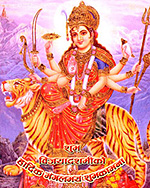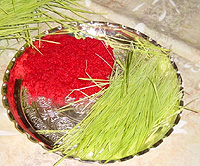 Dashain
Dashain
(दशैं) is the 15-day national festival of Nepal. The festival falls around
September-October, after the rice harvest. This festival is known for emphasis
on family gatherings, as well as on a renewal of community ties. People will
return from all parts of the world, as well as different parts of the country,
to celebrate together.
The festival is a blend of Hindu Tantrik and animistic harvest festival
traditions. On the first day, called Ghatasthapana, the "Dashain Ghar", or
special worship room, is set up. This room is used to worship the astha-matrikas
(the 8 tantrik goddesses) as well as the nava durgas (the 9 durga goddesses), to
whom the festival is consecrated. Married women will say the mantras for the
next fifteen days, and guard the goddesses. Barley is sowed in big earthern
pots. These seeds will sprout in ten days. The sprouts, which symbolize a good
harvest, will be decoratively placed on the heads of family members later on in
the festival as a blessing.
On the seventh day, Fulpaati, the town of Gorkha sends an offering of flowers to
the King of Nepal. A band associated with the army also plays its music and goes
through the old core of Kathmandu.
The eighth day, Asthami, is the day of sacrifices. Goddess temples all over the
Kathmandu Valley receive sacrifices, ranging from goats and buffaloes to ducks
and chickens. Blood, symbolic for its fertility, is offered to the goddesses.
This meat is taken home and cooked as "prasad", or food blest by divinity. This
food is offered, in tiny leaf plates, to the household gods, then distributed
amongst the family. Eating this food is thought to be auspicious.
Sacrifices continue on Navami, the ninth day. Families will visit various
temples around the Kathmandu Valley. On the tenth day, "Dashami," a mixture of
rice, yogurt and vermillion will be prepared by the women. This preparation is
known as "tika". Elders put this on the forehead of younger relatives to bless
them with fertility and abundance in the upcoming year. The red also symbolizes
the blood that ties the family together. Elders will give "dakshina", or a small
amount of money, to younger relatives at this time. The tika continues for five
days, during which time people also gather to play cards around massive amounts
of food and drink.
In several parts of Nepal, Dashain is the only time of the year when people
receive a set of new clothing. Likewise, in poorer families, the animal
sacrifice was eagerly anticipated since it might be the only animal protein the
family would eat all year. This may be true in certain parts of Nepal where food
is in low supply, but is less so in the cities. In general, the tradition of
sacrifice is lessening with the easy availability of meat for daily consumption,
and with the influences of Vaishnav Hindus (who are vegetarian).
In recent times, Dashain has become commercialized, with industries sponsoring
events around the festival to sell goods.
During the month of Kartik (late September and early October), the Nepalese
people indulge in the biggest festival of the year, Dashain. Dashain is the
longest and the most auspicious festival in the Nepalese annual calendar,
celebrated by Nepalese of all caste and creed throughout the country. The
fifteen days of celebration occurs during the bright lunar fortnight ending on
the day of the full moon. Thorough out the kingdom of Nepal the goddess Durga in
all her manifestations are worshiped with innumerable pujas, abundant offerings
and thousands of animal sacrifices for the ritual holy bathing, thus drenching
the goddess for days in blood.
Dashain commemorates a great victory of the gods over the wicked demons. One of
the victory stories told is the Ramayan, where the lord Ram after a big struggle
slaughtered Ravana, the fiendish king of demons. It is said that lord Ram was
successful in the battle only when goddess Durga was evoked. The main
celebration glorifies the triumph of good over evil and is symbolized by goddess
Durga slaying the terrible demon Mahisasur, who terrorised the earth in the
guise of a brutal water buffalo. The first nine days signify the nine days of
ferrous battle between goddess Durga and the demon Mahisasur. The tenth day is
the day when Mahisasur was slain and the last five days symbolise the
celebration of the victory with the blessing of the goddess. Dashain is
celebrated with great rejoice, and goddess Durga is worshiped throughout the
kingdom as the divine mother goddess.
In preparation for Dashain every home is cleansed and beautifully decorated,
painted as an invitation to the mother goddess, so that she may visit and bless
the house with good fortune. During this time the reunion of distant and nearby
relatives occur in every household. The market is filled with shoppers seeking
new clothing, gifts, luxuries and enormous supplies of temple offering for the
gods, as well as foodstuffs for the family feasting. Thousands of sheep, goats,
ducks, chicken and water buffalo are prepared for the great slaughter. All types
of organisations are closed for ten to fifteen days. Labourers are almost
impossible to find; from the poor to the rich, all enjoy the festive mood.
Anywhere you go the aroma of 'Vijaya Dashami' is found.
The first nine days of Dashain are called Nawa Ratri when tantric rites are
conducted. In Nepal the life force is embodied in the divine energy and power of
the female, depicted as goddess Durga in her many forms. All goddess who
emanated from goddess Durga are known as devis, each with different aspects and
powers. In most mother goddess temples the deity is represented simply as a
sacred Kalash, carved water jug or multiple handed goddess holding murderous
weapons. During these nine days people pay their homage to the goddess. If she
is properly worshiped and pleased good fortunes are on the way and if angered
through neglect then misfortunes are around the corner. Mother goddess is the
source of life and everything.
The first day of Dashain is called Ghatasthapana, which literally means pot
establishing. On this day the kalash, (holy water vessel) symbolising goddess
Durga often with her image embossed on the side is placed in the prayer room.
The kalash is filled with holy water and covered with cowdung on to which seeds
are sown. A small rectangular sand block is made and the kalash is put in the
centre. The surrounding bed of sand is also seeded with grains. The
ghatasthapana ritual is performed at a certain auspicious moment determined by
the astrologers. At that particular moment the priest intones a welcome,
requesting goddess Durga to bless the vessel with her presence.
The room where the kalash is established is called 'Dashain Ghar'. Generally
women are not allowed to enter the room where Dashain puja is being carried out.
A priest or a household man worships the kalash everyday once in the morning and
then in the evening. The kalash and the sand are sprinkled with holy water
everyday and it is shielded from direct sunlight. By the tenth day, the seed
will have grown to five or six inches long yellow grass. The sacred yellow grass
is called 'Jamara'. It is bestowed by the elders atop the heads of those younger
to them during the last five days when tika is put on. The jamara is taken as a
token of Goddess Durga as well as the elders blessing.
As days passes by regular rituals are observed till the seventh day. The seventh
day is called 'Fulpati'.
In fulpati, the royal kalash filled with holy water, banana stalks, jamara and
sugar cane tied with red cloth is carried by Brahmans on a decorated palanquin
under a gold tipped and embroidered umbrella. The government officials also join
the fulpati parade. With this the Dashain feasting starts.
The eighth day is called the Maha Asthami: The fervour of worship and sacrifice
to Durga and Kali increases. On this day many orthodox Hindus will be fasting.
Sacrifices are held in almost every house through out the day. The night of the
eighth day is called 'Kal Ratri', the dark night. Hundreds of goats, sheep and
buffaloes are sacrificed at the mother goddess temples. The sacrifice continues
till dawn. While the puja is being carried out great feasts are held in the
homes of common people where large amount of meat are consumed.
The ninth day is called Nawami: Temples of mother goddess are filled with people
from dawn till dusk. Animals mostly black buffaloes are slaughtered to honour
Durga the goddess of victory and might and to seek her blessing. Military bands
play war tunes, guns boom and officers with beautifully decorated medals in full
uniform stand there. When the function ends the courtyard is filled ankle deep
with blood. On this very day the god Vishwa Karma, the God of creativity is also
worshiped. All factories, vehicles, any machinery instruments and anything from
which we make a living are worshiped. We also give sacrifices to all moving
machinery like cars, aeroplanes, trucks etc. to get the blessing from goddess
Durga for protection for vehicles and their occupants against accidents during
the year. The entire day is colourful.
The tenth day is the Dashami: On this day we take tika and jamara from our
elders and receive their blessing. We visit our elders in their home and get
tika from them while our younger ones come to our home to receive blessing from
us. The importance of Dasain also lies in the fact that on this day family
members from far off and distant relatives come for a visit as well as to
receive tika from the head of the family. This function continues for four days.
After four days of rushing around and meeting your relatives Dashain ends on the
full moon day, the fifteenth day. In the last day people stay at home and rest.
The full moon day is also called 'Kojagrata' meaning 'who is awake'. The Hindu
goddess of wealth Laxmi is worshipped. On this day the goddess Laxmi is given an
invitation to visit each and everyone.
After Dashain everyone settles back to normal. After receiving the blessing of
goddess Durga, people are ready to work and acquire virtue, power and wealth.
Dashain thus is not only the longest festival but also the most anticipated one
among all the festivals of Nepal.

































No comments:
Post a Comment